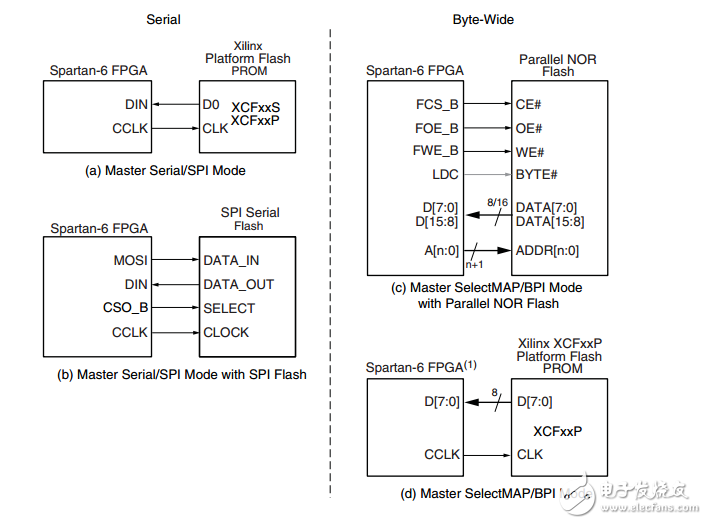
资料下载

Spartan-6 FPGA Configuration User Guide
Spartan®-6 FPGAs are configured by loading application-specific configuration data—a bitstream—into internal memory. Spartan-6 FPGAs can load themselves from an external nonvolatile memory device or they can be configured by an external smart source, such as a microprocessor, DSP processor, microcontroller, PC, or board tester. In any case, there are two general configuration datapaths. The first is the serial datapath that is used to minimize the device pin requirements. The second datapath is the 8- or 16-bit datapath used for higher performance or access (or link) to industry-standard interfaces, ideal for external data sources like processors, or x8- or x16-parallel flash memory. Like processors and processor peripherals, Xilinx® FPGAs can be reprogrammed, in system, on demand, an unlimited number of times. Because Xilinx FPGA configuration data is stored in CMOS configuration latches (CCLs), it must be reconfigured after it is powered down. The bitstream is loaded each time into the device through special configuration pins. These configuration pins serve as the interface for a number of different configuration modes: • JTAG configuration mode • Master Serial/SPI configuration mode (x1, x2, and x4) • Slave Serial configuration mode • Master SelectMAP/BPI configuration mode (x8 and x16) • Slave SelectMAP configuration mode (x8 and x16) The configuration modes are explained in detail in Chapter 2, Configuration Interface Basics. The specific configuration mode is selected by setting the appropriate level on the mode input pins M[1:0]。 The M1 and M0 mode pins should be set at a constant DC voltage level, either through pull-up or pull-down resistors (2.4 kΩ), or tied directly to ground or VCCO_2. The mode pins should not be toggled during or before configuration but can be toggled after. See Chapter 2, Configuration Interface Basics, for the mode pin setting options. The terms Master and Slave refer to the direction of the configuration clock (CCLK): • In Master configuration modes, the Spartan-6 device drives CCLK from an internal oscillator by default or optional external master clock source GCLK0/USERCCLK. To select the desired frequency, the BitGen -g ConfigRate option is used for the internal oscillator. The default is 2 MHz. The CCLK output frequency varies with process, voltage, and temperature. The data sheet FMCCKTOL specification defines the frequency tolerance. A frequency tolerance of ±50% means that a ConfigRate setting of 10 could generate a CCLK rate of between 5 MHz and 15 MHz.The BitGen sectionof UG628, Command Line Tools User Guide provides more information. After configuration, the oscillator is turned OFF unless one of these conditions is met: • SEU detection is used. • CFGMCLK in STARTUP primitive is connected. • The internal clock source is selected in SUSPEND mode (the oscillator is on only during the WAKEUP sequence)。 • Encryption is enabled. CCLK is a dual-purpose pin. Before configuration, there is no on-chip pull-up. After configuration, it is a user pin unless PERSIST is used. • In Slave configuration modes, CCLK is an input. The JTAG/boundary-scan configuration interface is always available, regardless of the mode pin settings.

声明:本文内容及配图由入驻作者撰写或者入驻合作网站授权转载。文章观点仅代表作者本人,不代表电子发烧友网立场。文章及其配图仅供工程师学习之用,如有内容侵权或者其他违规问题,请联系本站处理。 举报投诉
- 相关下载
- 相关文章






